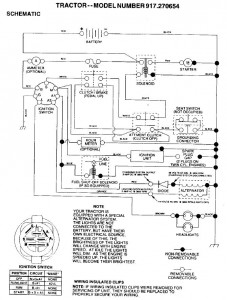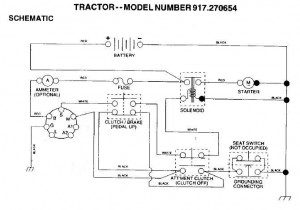McGyverin’ the mower
I can’t remember if I’ve mentioned this in the past, but I am a genius. I am like Stephen Hawking and Yogi Berra rolled into one very strange tall gentleman with full use of his various limbs but very bad at sports. So maybe that was a poor simile. Or maybe it was just so smart it broke your brain. Who’s to know? Other than me, of course.
My brilliance was confirmed over the weekend when I attempted to mow my lawn. I have a fairly sizeable patch of property, so a few years ago a got a used riding mower that has taken every ounce of my considerable mechanical skills to keep running. I’ve replaced blades, batteries, and bearings; adjusted pulleys, decks, and brakes; and even managed to keep a tire inflated with that weird green tire patching goo they sell that’s pretty much useless in any automotive application.
I topped off the gas tank, fired the mower up, and pulled it out into the yard, at which point I remembered that a small bungee cord that holds on part of the mulcher had broken and a cover had been lost, such that the mower would throw “mow muffins” all over the place instead of turning them into a fine grass dust. I decided to simply replace the bungee with a piece of clothesline, and since I was going to be fiddling around only inches from the blades, I thought it best to turn the mower off rather than trust the little clutch that disengages the blades. I got the cover tied back on, sat down atop my trusty steed, and turned the key.
Nothing. Not a click. Not a whirr. Not the telltale grinding that indicates a bad starter, not the constant cycling of an engine that’s spinning but just won’t fire up, nothing. Usually when this happens it’s because I’m doing something stupid, like trying to start it in gear with the clutch up, or trying to start it with the blades engaged; Sears is smart AND lawsuit-conscious, so there are a million safety switches to keep you from starting the dang thing in top gear and flying off out of control at a breakneck 5.5mph. But I was satisfying all of them. Brake on, neutral gear, butt firmly weighting down the seat switch, and nothing. There’s a small ammeter on the dashboard that indicated that juice was being delivered somewhere, but where?
I suspected the battery might’ve been shot; I don’t start the thing between October and April, so the batteries tend to lose voltage as they wear out over the winter, but this one was only about 2 months old. After a few minutes of fruitless searching I was unable to locate my electronic multimeter (my genius does not extend to organization; my garage looks like a Katamari exploded in it) so I said to hell with it and decided to just bypass the battery and jump start the mower with my van.
I connected all the cables, turned the key: nothing. I heard a faint “click” when switching to the “running” position, which indicated to me that the mower could draw power if I could just get it going, but turning the key to “start” did nothing. I disconnected the jumper cables from the van and gently touched them together, getting sparks galore, so the battery seemed to be okay. I then had to spend a solid half an hour digging through my horrendously filthy garage to find the multimeter, which I finally located under various bicycle parts and something that smelled suspiciously like a raccoon turd. I stuck it on the battery, which reported 12.35 volts, about what one would expect. The plot, as they say, thickened.
I decided it was time to go inside and do a little research. I have the owner’s manual on my lappy, which includes a helpful schematic that looks like this (click to enlarge):
That looks crazy complicated, but it’s not too bad, particularly if you’re aware that only part of it pertains to actually starting the engine:
Basically what it says is that current flows from the battery, through a fuse and an ammeter, and then reaches the ignition switch, which when turned to “start” forwards that current through the clutch/brake sensor (to make sure the clutch is disengaged, and the brake on), then through the “attachment” clutch sensor (to make sure the blades are disengaged), and then to the solenoid, which is a special kind of switch then when fed a small amount of current, allows a much larger amount of current to flow through another circuit and activate the starter. In short, either one of the switches or sensors is broken, or the solenoid is broken. All of which are fairly cheap to replace, except that
- They would take 5-6 days to arrive, and
- We were having a barbecue on Sunday for which I’d prefer the grass be ankle-high instead of mid-shin.
Faced with the prospect of mowing 2/3 of an acre with a 30″ push mower (which would take 3-4 hours), I had the lightning bolt of genius that characterizes so much of my life: all the solenoid does is let those various switches and sensors tell it what to do, which is supply current to the starter. Theoretically I could just supply the current to the starter by pressing one end of a wire to the positive terminal on the battery, and the other end to the input connection on the starter. So I got some gloves and goggles, and did exactly that. VROOOOOM! It fired right up, and I finished mowing, being careful not to turn the sucker off no matter what.
The dilemma I’m faced with now is, do I order a whole bunch of new switches and sensors and a solenoid ($45), or do I simply get a nice heavy gauge wire and a cool-looking starter button to bypass all that stuff and just get this awesome switch and a thick wire. I think we know the answer.



